
- The Gift That Keeps on Giving
- A Gift with Compound Interest
- A Conversation with Elisabeth Remak-Honnef, Head of Special Collections and Archives at UC Santa Cruz
- Exhibit Opening June 8th: Activism in the Archives: Radical Imaginaries in the Papers of Ruth-Marion Baruch, John Thorne, and Karen Tei Yamashita
- Quote of the Month
The Gift That Keeps on Giving I am thrilled to announce the recent endowment of the University Librarian position at the UC Santa Cruz University Library. The one-million-dollar endowment was made possible by the visionary support of Claudia and Alec Webster and the Webster Family Foundation and a matching grant from the Presidential Chair Program of the UC Office of the President. The position will now be known as the Richard L. Press University Librarian Presidential Chair, in honor of retired university librarian Richard Press, the father of Environmental Studies Professor Daniel Press. This is one of only three endowed University Librarian positions among the ten UC campuses.
I am thrilled to announce the recent endowment of the University Librarian position at the UC Santa Cruz University Library. The one-million-dollar endowment was made possible by the visionary support of Claudia and Alec Webster and the Webster Family Foundation and a matching grant from the Presidential Chair Program of the UC Office of the President. The position will now be known as the Richard L. Press University Librarian Presidential Chair, in honor of retired university librarian Richard Press, the father of Environmental Studies Professor Daniel Press. This is one of only three endowed University Librarian positions among the ten UC campuses.
What does this mean for the Library? It is a gift that will keep on giving, so to speak. It means that we will have a growing fund to support initiatives related to the University Archives. My first action as the first holder of this title will be to hire the first-ever University Archivist at UC Santa Cruz. That’s a lot of firsts, beginning what I know will be a long chain of benefits to our great Library thanks to this endowment. We plan to post the University Archivist position soon, so that our successful candidate can begin work before the end of 2016.
I would like to personally and publicly thank the Websters for their faith in me, the position, and the University Library. As you’ll read in this newsletter, they deeply understand the evolving and integral role of libraries in the academic enterprise. I look forward to proving them right!
Elizabeth Cowell
University Librarian
Joop Rubens
The generosity of Alec and Claudia Webster is transforming UC Santa Cruz. With every gift, the couple strategically highlights another engine of success on campus, be it the Center for Agroecology and Sustainable Food Systems, our Natural Reserves, or restoring the Cowell Hay Barn.
Most recently Alec and Claudia have given a $500,000 gift to the Library, which will be matched 100% by the University to install the Richard L. Press University Librarian Presidential Chair. I spoke with them to find out why they directed this latest gift to our library and why they wanted to honor Richard Press.
Joop Rubens: What prompted you to make a gift to the UC Santa Cruz Library?
Alec & Claudia: Just as much as we see the Cowell Hay Barn as the moral hub of the campus, we think of the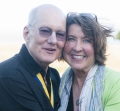 University Library as the academic hub. Campus life evolves around the Library. And with Elizabeth’s leadership and vision, we are talking about much more than just a facility. Elizabeth opened our eyes to what a library could be: A place where we find answers, where you can collaborate with others or choose to study. A collision space, where people come together, find access to learning resources, and create solutions. It is also where you can see, touch, and feel historic objects, literature, photographs. Which leads us to Special Collections. We had a particular interest in Special Collections and wanted to help uncork the hidden treasures on campus.
University Library as the academic hub. Campus life evolves around the Library. And with Elizabeth’s leadership and vision, we are talking about much more than just a facility. Elizabeth opened our eyes to what a library could be: A place where we find answers, where you can collaborate with others or choose to study. A collision space, where people come together, find access to learning resources, and create solutions. It is also where you can see, touch, and feel historic objects, literature, photographs. Which leads us to Special Collections. We had a particular interest in Special Collections and wanted to help uncork the hidden treasures on campus.
JR: Why Special Collections?
A & C: UC Santa Cruz Special Collections has some incredible archives. There is the Ansel Adams photography, the Chadwick Papers, and so much more. But the archived material is not as accessible as it can be. And so we felt it would be important to open it up for people. As Beth Remak-Honnef told us: “What’s the worst thing that could happen? Something breaks? Even if we break something after it was used many times over, it will have had more use than if it sits in a collection and is never seen or touched, or experienced.” A gift that allows the University to further open up its Special Collections is a gift with compound interest. Students will now have the opportunity to see something, to touch something, and be inspired and informed by a document or a photograph that was previously stuck in a box on a shelf. Some of these students will use that experience to construct a thesis, or to write a paper. Multiply that process by countless students over the next few years, and all of a sudden the collection becomes a tool that could change the world.
JR: Your gift establishes the Richard L. Press University Librarian Presidential Chair. Why Richard Press?
A & C: We met Richard Press through his son Daniel, who is a Professor in Environmental Studies on campus. Richard, a retired university librarian, now owns a bookstore that specializes in collecting fine and scholarly books. He is just a wonderful man who has devoted his life to learning, accessibility, and rare books. For years now he has been curating his own special collection in his bookstore in Sacramento. Not as an investor, rather because he just loves books. Hi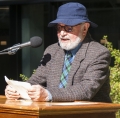 s bookstore probably does not make a fortune, but that’s not why he is collecting and caring for his books. This is his life’s work. It is what he loves doing and what he is deeply passionate about. Richard also knows everything about the UC Santa Cruz Special Collections. It shows just how passionate he is about the value of a library collection. He helped us see how you can gain a more complete picture of history when you have some of the material pieces. It is beautiful when people collect groups of items out of passion. Especially if those items become accessible to the public. Richard is a special person. To us, he is what people in Japan call a “Living Treasure.” He is more than deserving of this honor. He has spent a lifetime helping people refine their tastes and inspiring them to reach for the best of what’s available, not just books but also art, etc.
s bookstore probably does not make a fortune, but that’s not why he is collecting and caring for his books. This is his life’s work. It is what he loves doing and what he is deeply passionate about. Richard also knows everything about the UC Santa Cruz Special Collections. It shows just how passionate he is about the value of a library collection. He helped us see how you can gain a more complete picture of history when you have some of the material pieces. It is beautiful when people collect groups of items out of passion. Especially if those items become accessible to the public. Richard is a special person. To us, he is what people in Japan call a “Living Treasure.” He is more than deserving of this honor. He has spent a lifetime helping people refine their tastes and inspiring them to reach for the best of what’s available, not just books but also art, etc.
JR: As I am raising support for the library, people ask me “Who uses a library in today’s digital age?” What’s your reaction to that?
A & C: Libraries are changing, but they are more important than ever before. A library is a resource. You walk in, see and experience new materials. Few people probably use a library just for its books today. But that does not mean the place has lost its purpose. Look at Elizabeth’s library. It is full of students. You know how in an old-fashioned bookstore or library you would be able to run your fingers along the bindings? That was fun and interesting. But that’s the past. The information is still there, but it comes in a different form. A library still exposes us to knowledge. And it does this now in a much more connected way. Many libraries today have a café, have group study rooms, and bring people in contact. It’s a collision space. Who uses libraries today? Most of the students. It’s an exciting time for libraries.
A Conversation with Elisabeth Remak-Honnef, Head of Special Collections and Archives at UC Santa Cruz
Joop Rubens: What is the purpose of Special Collections?
ERH: Special Collections is here on campus to provide access to rare and unique materials and to provide research 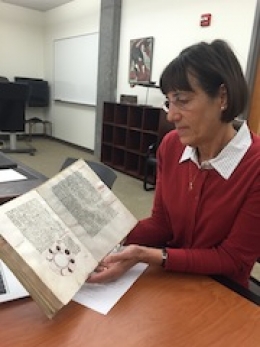 opportunities for undergraduate and graduate students, faculty, outside researchers, and community members. Anyone has access to the collections as long as they register as a user. In addition to providing access to the collection, we are working to provide fellowships for grad students: for example, our Center for Archival Research and Training program (CART) is nearing the end of a very successful first year. This is a 10-week, 100-hour training program where grad students help to process archival collections related to their research interests. This year, for instance, we had PhD students in Literature, History, and the History of Art and Visual Culture program working on social activism collections. Next year we will have three students who will help us process and catalog the Lick Observatory Records and the Ken Norris papers.
opportunities for undergraduate and graduate students, faculty, outside researchers, and community members. Anyone has access to the collections as long as they register as a user. In addition to providing access to the collection, we are working to provide fellowships for grad students: for example, our Center for Archival Research and Training program (CART) is nearing the end of a very successful first year. This is a 10-week, 100-hour training program where grad students help to process archival collections related to their research interests. This year, for instance, we had PhD students in Literature, History, and the History of Art and Visual Culture program working on social activism collections. Next year we will have three students who will help us process and catalog the Lick Observatory Records and the Ken Norris papers.
JR: Why is wide access to the archive important?
ERH: It’s really important to give students access to the collections. To be able to touch a 500-year-old book, for instance, and to smell the materials it is made from leaves a strong impression. We introduce students not just to the contents of a book, but let them experience the archeology of the book as an object. Who made it, how was it used over the course of hundreds of years? When you touch something that was created by hand over 500 years ago, it helps you understand the value this book had for people over centuries. How many people used that book, how many wars and crises did it survive? You are feeling its history. You are in fact holding the physical reflection of our respect for books, knowledge, and the written word.
instance, and to smell the materials it is made from leaves a strong impression. We introduce students not just to the contents of a book, but let them experience the archeology of the book as an object. Who made it, how was it used over the course of hundreds of years? When you touch something that was created by hand over 500 years ago, it helps you understand the value this book had for people over centuries. How many people used that book, how many wars and crises did it survive? You are feeling its history. You are in fact holding the physical reflection of our respect for books, knowledge, and the written word.
Collections do not need to be really old to leave a deep impression. Karen Yamashita and her class came to Special Collections a few days ago with her advanced creative writing students. She came to show her own archive and highlight the perseverance it takes to get published. Instead of looking at a monitor and seeing a digital copy of her correspondence with publishers, students were able to see and touch the actual paper copies of correspondence, including rejection letters Karen Yamashita received as a beginning writer. The students were able to see, by looking at multiple boxes, how much work it took to get a manuscript published.
Another example of the power of an archive is from a few months ago when Alan Christy’s lower-division history students came in to do research on the world-renowned peace activist Earle Reynolds. We were able to show the students 59 boxes of materials, including extensive biographical documentation, from the Earle Reynolds archive. Many of his publications and research projects addressed the effects of nuclear radiation on the children of Hiroshima. He and his family traveled the seas on their boat, the Phoenix, as an anti-nuclear protest. In addition to studying texts, the students were able to hold ship and radio licenses, as well as nautical maps used by the Reynolds family. They listened to audiotapes of some of his lectures and examined photographs of his many trips.
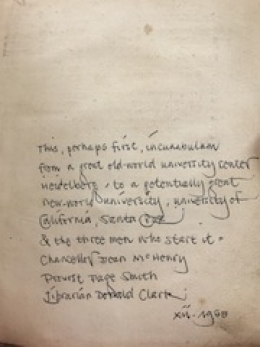 We want people to have easy access to our holdings. Much of the world’s knowledge is online now, but it is still very important for people to see how knowledge was created, distributed, and preserved in the past. It is great to have the chance to see what kinds of materials a peace activist considered important to hold on to, and to observe first-hand how he collected materials representative of what was happening around him. Personal engagement with these kinds of collections allows different kinds of unique experiences. A few weeks ago we had some high-school students visiting from Watsonville: these students had never been in a research library or museum and they did not realize that they could learn by actually touching and handling materials. A group of UCSC seniors came in recently for a one-hour session on rare books; some of them were so engrossed with the materials that they didn’t realize that 90 minutes had passed and they were late for their next class.
We want people to have easy access to our holdings. Much of the world’s knowledge is online now, but it is still very important for people to see how knowledge was created, distributed, and preserved in the past. It is great to have the chance to see what kinds of materials a peace activist considered important to hold on to, and to observe first-hand how he collected materials representative of what was happening around him. Personal engagement with these kinds of collections allows different kinds of unique experiences. A few weeks ago we had some high-school students visiting from Watsonville: these students had never been in a research library or museum and they did not realize that they could learn by actually touching and handling materials. A group of UCSC seniors came in recently for a one-hour session on rare books; some of them were so engrossed with the materials that they didn’t realize that 90 minutes had passed and they were late for their next class.
Exhibit Opening June 8th: Activism in the Archives: Radical Imaginaries in the Papers of Ruth-Marion Baruch, John Thorne, and Karen Tei Yamashita
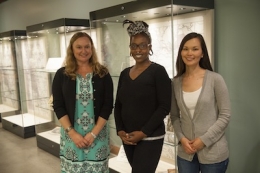 The Center for Archival Research and Training (CART) program is a yearly fellowship program for graduate students interested in learning about archival research. This year, students created an exhibit with materials from four new collections: the Ruth-Marion Baruch & Pirkle Jones Collections, curated by crystal am nelson, a grad student in the History of Art and Visual Culture program; the John Thorne Collection, curated by Samantha Williams, History; and the Karen Tei Yamashita Collection, curated by Melissa Eriko Poulsen, Literature. Containing a diverse set of materials, these collections are united by the insights they offer into the lives and works of four activists with roots in the San Francisco Bay Area. Items from each of these archives will be on display in McHenry Library beginning on June 8th, accompanied by a digital exhibit hosted on the Library's Special Collections and Archives website.
The Center for Archival Research and Training (CART) program is a yearly fellowship program for graduate students interested in learning about archival research. This year, students created an exhibit with materials from four new collections: the Ruth-Marion Baruch & Pirkle Jones Collections, curated by crystal am nelson, a grad student in the History of Art and Visual Culture program; the John Thorne Collection, curated by Samantha Williams, History; and the Karen Tei Yamashita Collection, curated by Melissa Eriko Poulsen, Literature. Containing a diverse set of materials, these collections are united by the insights they offer into the lives and works of four activists with roots in the San Francisco Bay Area. Items from each of these archives will be on display in McHenry Library beginning on June 8th, accompanied by a digital exhibit hosted on the Library's Special Collections and Archives website.
"For me, the university library is the heart and soul of teaching and research in a university. It favors no one department. It is ecumenical in support of all academic endeavors and, in turn, must be recognized by all as the indispensable resource it is." Richard L. Press
From the Investiture Ceremony held on on the lawn of McHenry Library, May 28, 2015.
Contributors: Elizabeth Cowell, Joop Rubens, Samantha Williams
Production: Linda Hunt
Copyediting and proofreading: Mark Engel
Photography: Joop Rubens, Linda Hunt and Carolyn Lagattuta


 Santa Cruz, CA
Santa Cruz, CA



